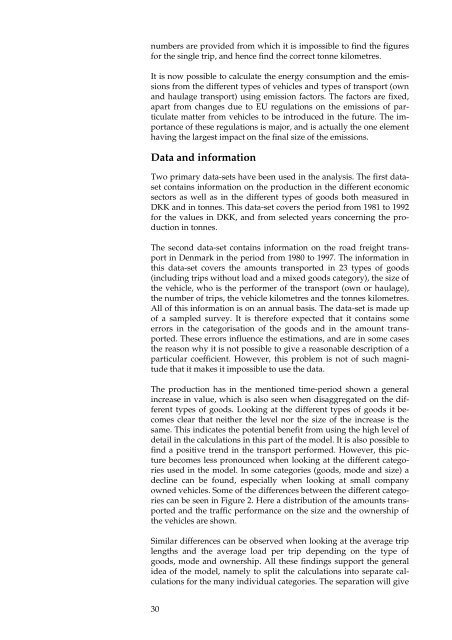En model for godstransportens udvikling - DCE - Nationalt Center for ...
En model for godstransportens udvikling - DCE - Nationalt Center for ...
En model for godstransportens udvikling - DCE - Nationalt Center for ...
You also want an ePaper? Increase the reach of your titles
YUMPU automatically turns print PDFs into web optimized ePapers that Google loves.
numbers are provided from which it is impossible to find the figures<br />
<strong>for</strong> the single trip, and hence find the correct tonne kilometres.<br />
It is now possible to calculate the energy consumption and the emissions<br />
from the different types of vehicles and types of transport (own<br />
and haulage transport) using emission factors. The factors are fixed,<br />
apart from changes due to EU regulations on the emissions of particulate<br />
matter from vehicles to be introduced in the future. The importance<br />
of these regulations is major, and is actually the one element<br />
having the largest impact on the final size of the emissions.<br />
Data and in<strong>for</strong>mation<br />
Two primary data-sets have been used in the analysis. The first dataset<br />
contains in<strong>for</strong>mation on the production in the different economic<br />
sectors as well as in the different types of goods both measured in<br />
DKK and in tonnes. This data-set covers the period from 1981 to 1992<br />
<strong>for</strong> the values in DKK, and from selected years concerning the production<br />
in tonnes.<br />
The second data-set contains in<strong>for</strong>mation on the road freight transport<br />
in Denmark in the period from 1980 to 1997. The in<strong>for</strong>mation in<br />
this data-set covers the amounts transported in 23 types of goods<br />
(including trips without load and a mixed goods category), the size of<br />
the vehicle, who is the per<strong>for</strong>mer of the transport (own or haulage),<br />
the number of trips, the vehicle kilometres and the tonnes kilometres.<br />
All of this in<strong>for</strong>mation is on an annual basis. The data-set is made up<br />
of a sampled survey. It is there<strong>for</strong>e expected that it contains some<br />
errors in the categorisation of the goods and in the amount transported.<br />
These errors influence the estimations, and are in some cases<br />
the reason why it is not possible to give a reasonable description of a<br />
particular coefficient. However, this problem is not of such magnitude<br />
that it makes it impossible to use the data.<br />
The production has in the mentioned time-period shown a general<br />
increase in value, which is also seen when disaggregated on the different<br />
types of goods. Looking at the different types of goods it becomes<br />
clear that neither the level nor the size of the increase is the<br />
same. This indicates the potential benefit from using the high level of<br />
detail in the calculations in this part of the <strong>model</strong>. It is also possible to<br />
find a positive trend in the transport per<strong>for</strong>med. However, this picture<br />
becomes less pronounced when looking at the different categories<br />
used in the <strong>model</strong>. In some categories (goods, mode and size) a<br />
decline can be found, especially when looking at small company<br />
owned vehicles. Some of the differences between the different categories<br />
can be seen in Figure 2. Here a distribution of the amounts transported<br />
and the traffic per<strong>for</strong>mance on the size and the ownership of<br />
the vehicles are shown.<br />
Similar differences can be observed when looking at the average trip<br />
lengths and the average load per trip depending on the type of<br />
goods, mode and ownership. All these findings support the general<br />
idea of the <strong>model</strong>, namely to split the calculations into separate calculations<br />
<strong>for</strong> the many individual categories. The separation will give<br />
30

















